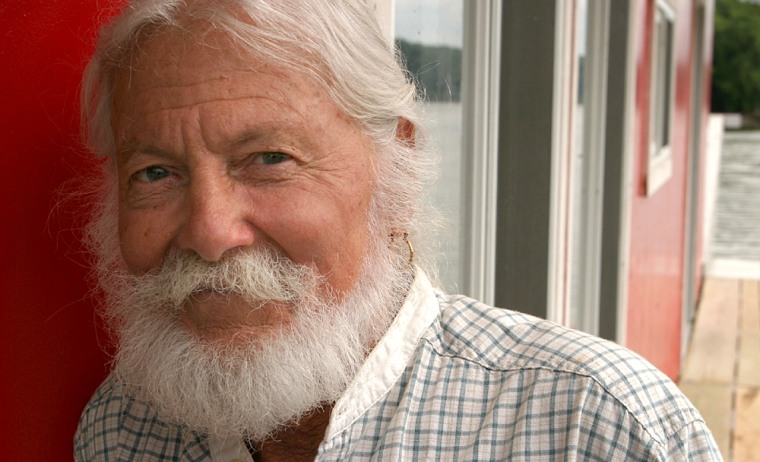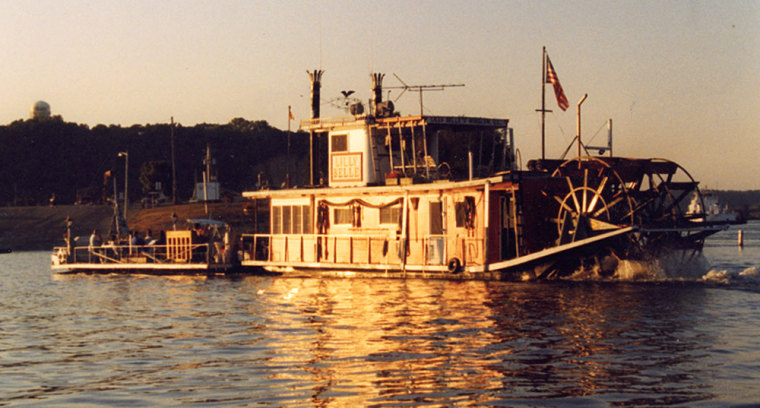When we set out to meet one of the nation’s leading raptor researchers to learn about efforts to restore obliterated avian habitat in a national wildlife refuge, little did we realize that we would encounter a Willie Nelson look-alike with a genius for building boats. But as we are learning on the fourth day of our journey down the length of the Mississippi River, this is a ribbon of America where you should expect the unexpected.
We thought we knew what we were in for when we arrived under a light rain at Dubuque’s newly redeveloped waterfront center and found Jon Stravers waiting for us.
Stravers, 55, is an expert on raptors, but he also is a spokesman for the Audubon Society’s Upper Mississippi River Campaign, and in that role had agreed to show us what’s being done to try and prevent the river’s silt from filling in critical habitat for the birds that either pass through the valley on their way to summer and winter grounds or live there year round.
He fulfilled his end of the bargain, taking us by boat through Lock 11 to show us the flocks of white pelicans, double-crested cormorants and great blue herons that testify to the benefits of new habitat-restoration efforts in the Upper Mississippi River National Wildlife and Fish Refuge.

But before he delivered the goods on the birds, our day took a turn into unexpected territory when a diminutive silver-haired fellow with a ponytail and a gold earring came padding barefoot out of the Audubon Ark – a 100-foot faux steamboat that Stravers’ group uses as a mobile public education laboratory -- and introduced himself as Ike Hastings.
We initially pegged our new acquaintance as local color, but that first impression was quickly torpedoed when we were informed that he not only was the captain of the vessel, but had built it by hand in the 1950s. Our jaws dropped a bit further upon hearing that he was a 79-year-old retired school art teacher who had built more then 40 other boats by hand as well as an experimental amphibious biplane over the preceding decades.
A World War II veteran who fought his way through the Pacific at the side of his older brother, Hastings attended the University of Wisconsin on the GI Bill intending to become a mechanical engineer, but switched to art and then teaching so he could spend his summers on the river.
Freedom on the river
“I’ve always liked it on the river,” he said. “It’s about the last place where you don’t have someone running the radar clock on you or telling you … what you can do. If you don’t like your neighbors you can always cut the line and drift on down a ways.”
Since building his first boat at the age of 7 with help from his dad, Hastings has built racing boats, fishing boats, cruise boats and scull boats – not the kind favored by collegian rowers but low-slung craft that allow duck hunters to stealthily paddle to within yards of their prey.

But his crowning achievement is the Audubon Ark, which was named the Julia Belle during the years when he was raising his two sons on the boat. Built to look like a traditional Mississippi steamboat, the Ark is powered by a six-cylinder, air-cooled diesel engine that turns the paddle-wheel with two chain drives.
Hastings said he found inspiration for the boat in a situation that any parent can relate to.
“The boys were at a real noisy age … and it was intolerable on a rainy day,” he said. “So I thought ‘I‘m going to build a big boat so I can get away from them and read or sleep.’”
Not ready to rest on his laurels after selling the boat to the Audubon Society, Hastings is now building a second paddle-wheel riverboat – a 98-footer that he hopes to have skimming the river on its single-piece aluminum hull by early next year. He plans to christen it the Pickett Hastings after a relative who was unsuccessfully brought up for court-martial during the Civil War for swearing at a superior.
In search of vanishing birds
With the rain finally letting up, we left Hastings sitting in his captain’s chair, his toes wrapped around the wheel of the Ark, and joined Stravers for a quick run up the river in his 20-foot skiff to have a look at a man-made island constructed by the Army Corps of Engineers five years ago in an effort to restore vanishing bird habitat.

Stravers, known as “Hawk” as a result of his 28 years studying red-shouldered hawks and other raptors along the upper Mississippi River, explained that the construction of the dams and locks on the upper river caused the lower part of the “pools” that back up above them to become wide, lake-like environments. This, in turn, made small islands and marshlands favored by birds more susceptible to wind and wave erosion and many eventually vanished.
But the creation of the artificial Sunfish Island in the pool above Lock 11, just north of Dubuque, shows that the loss of such habitat is reversible, Stravers said.
“Immediately (after construction) the vegetation in that adjacent backwater responded … and now shore birds are using it, gulls and terns, waterfowl, pelicans and cormorants, all kind of birds are using that safe habitat inside that reconstructed island,” he said.
The evidence was plain to see during our tour of the leeward side of the island. Blackbirds and swallows could be seen perching and darting in a vast field of lotus, or water lilies, with foot-wide yellow flowers. White pelicans wheeled overhead as double-crested cormorants skimmed the river’s surface and sandpipers, great blue herons, great egrets and a kingfisher poked among the rocks and shells on the beach.
Environmentalists consider restoration of the habitat critical to the health of many bird species that use the Mississippi River as their flyway to and from their summer and winter grounds. Scientists estimate that 40 percent of the continent’s ducks, geese, swans and eagles live in or pass through the valley.
The construction of the artificial islands could become far more widespread if Congress approves an $8 billion legislative package that would include $5.7 billion for environmental restoration along the river.
Though that would not resolve the other serious problem affecting bird habitat along the river – the increased deposits of silt trapped behind the dams that clog the breeding and feeding grounds – the construction of the artificial islands would be a good beginning toward rectifying the problem, Stravers said.
The key, if the legislation passes, will be whether Congress comes through with the money for the environmental measures, he said, adding, “Historically, these things have been promised but never quite delivered.”
Our tour ended, Stravers deposited us back on the dock in Dubuque, where we were able to take a very brief tour of the new National Mississippi River Museum and Aquarium on the city’s waterfront, the centerpiece of a $188 million redevelopment project on the site of what used to be the Dubuque Boat and Boiler Co.
The museum features many educational and interactive exhibits detailing aspects of the Mississippi’s history, geography and ecology and is well worth visiting for any river aficionado.
Our time in Dubuque ended, we hopped back in our van and headed south to hook up with 29-year-old Chad Pregracke’s cleanup crew as they removed decades worth of junk from a remote beach. You can read more about his quest in tomorrow’s installment.
Reporter and media producer are traveling the length of the Mississippi in August and will be filing daily dispatches along the way. If you have a question or comment, mail us at .